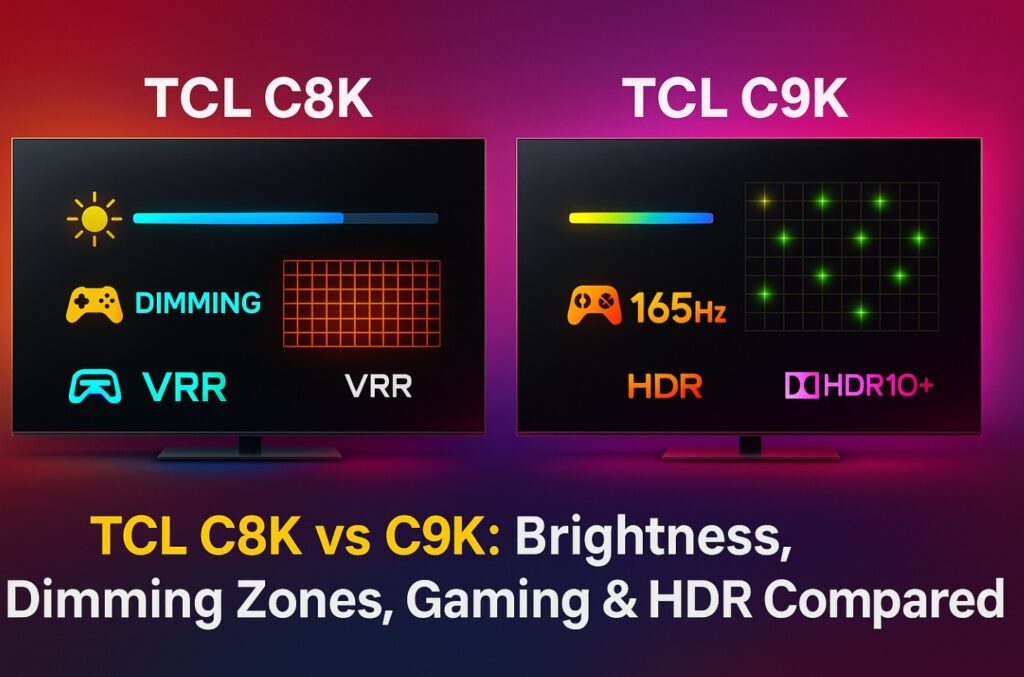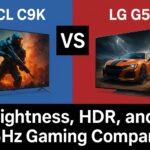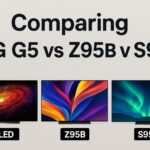The TCL C8K vs C9K debate isn’t just about specs — it’s about what kind of viewing experience you want in your living room. Both are part of TCL’s Mini-LED lineup, both promise eye-searing brightness and rich HDR, but the way they achieve it is different.
- The C8K is a powerful mid-to-upper tier option, bright enough for daylight sports and equipped with modern gaming features.
- The C9K sits above it, with more dimming zones, higher peak brightness, and refined local dimming control that edges closer to OLED in cinematic precision.
So, what’s the real difference? Let’s explore brightness, dimming zones, HDR tone mapping, gaming, and day-to-day usability — with a clear verdict at the end.
Quick Takeaways ⚡
| Feature | TCL C8K | TCL C9K | Best For |
|---|---|---|---|
| Dimming Zones (65″) | ~1,680 zones | ~5,184 zones (TCL Official) | C9K = cleaner blacks 🌌 |
| Brightness (peak HDR) | ~5,000 nits boost, lower sustained | Up to ~6,500 nits in spec sheets | C9K = brighter highlights 🌞 |
| Gaming | 144Hz VRR, low input lag | 144Hz VRR, slightly better tone mapping | Both excellent 🎮 |
| HDR Movies | Dolby Vision, HDR10, HLG; some blooming | Dolby Vision + better dimming; fewer halos | C9K = cinematic HDR 🎬 |
| Value | More affordable, strong mid-premium | Pricier, flagship tier | C8K = value 💰 |
Brightness & Dimming Zones
Mini-LED TVs live and die by how well they control their backlight. The number of dimming zones directly affects how clean highlights look and how well black levels are maintained.
TCL C8K
- The 65-inch C8K has around 1,680 zones of local dimming.
- Larger sizes scale up: ~2,176 (75″), ~2,880 (85″), and ~3,480–3,840 for the biggest models.
- In HDR mode, it can spike to ~5,000 nits in small highlights, but struggles to sustain that across the screen.
- Blooming (halo around bright objects on dark backgrounds) is visible, though manageable with Medium local dimming.
TCL C9K
- The 65-inch C9K ramps up to around 5,184 zones, three times as many as the C8K.
- This higher precision dramatically reduces blooming in dark HDR scenes.
- Peak brightness can reach 6,000–6,500 nits, with stronger sustained output than the C8K.
- Starfields, neon lights, and fireworks look cleaner, with less halo bleed.
👉 Verdict: The C9K is simply brighter and more controlled, especially in HDR movies. But the C8K remains impressive for its class.
Gaming: 144Hz, VRR & Responsiveness 🎮
Gaming is where TCL has surprised many enthusiasts — both the C8K and C9K deliver features usually reserved for high-end monitors.
TCL C8K
- Supports 144Hz refresh rate on PC via HDMI 2.1.
- Input lag ~6ms at 120Hz, low enough for competitive play.
- VRR (Variable Refresh Rate) works smoothly with PC and consoles.
- Dolby Vision Gaming supported on Xbox.
TCL C9K
- Same 144Hz VRR support, but local dimming behaves better with VRR enabled.
- HDR tone mapping in Game Mode is more consistent, keeping highlights intact.
- Input lag is slightly lower than the C8K, though both are excellent.
👉 Verdict: For PC gamers at 144Hz, both are stellar. The C9K has a slight edge for HDR gaming consistency, but C8K is still outstanding for the money.
HDR & Movie Performance 🎬
HDR is about more than brightness — it’s about how highlights, shadows, and mid-tones all blend together.
TCL C8K
- Supports HDR10, HDR10+, Dolby Vision, and HLG.
- Explosive HDR in bright scenes, great for sports and animations.
- In dark HDR movies, blooming around subtitles or stars can break immersion.
TCL C9K
- Supports the same HDR formats.
- Thanks to more dimming zones, HDR in dark rooms feels much closer to OLED.
- Starfields, neon cityscapes, and moody films show cleaner separation between black and bright elements.
👉 Verdict: For HDR movies in a dark room, the C9K is clearly superior. The C8K is still fun for casual HDR and daytime viewing.
Processing & Upscaling
TCL C8K
- Powered by AiPQ Processor Gen 2/3.
- AI enhancements for color and sharpness.
- Can sometimes push contrast too aggressively, crushing details.
TCL C9K
- Uses AiPQ Processor Gen 3+.
- Better at handling gradients and low-bitrate content (streaming).
- Refined tone mapping ensures HDR scenes feel more balanced.
👉 Verdict: C9K’s processing gives it an advantage for streaming, movies, and mixed-use.
Longevity & Reliability
- Both C8K and C9K are Mini-LED TVs → no burn-in risk.
- Great for marathon sessions of sports, news channels, or gaming with static HUDs.
- TCL reliability has improved year after year; firmware updates often fix early bugs.
👉 Verdict: In long-term safety, both beat OLED.
Advanced Tips & Settings
- C8K:
- Use Local Dimming on Medium in Game Mode → balance bloom vs detail.
- Turn off Eco mode to unlock full HDR brightness.
- C9K:
- For movies, Local Dimming High offers cleaner blacks.
- In HDR gaming, keep VRR on and run HDR calibration on PS5/Xbox.
Mistakes to Avoid 🚫
- Expecting the C8K to match the C9K in HDR starfields → more zones = cleaner blacks.
- Forgetting to enable 144Hz in GPU settings for PC → you’ll be stuck at 120Hz.
- Assuming burn-in risks → Mini-LED does not have the same limitations as OLED.
Real-World Impressions 🌍
- C8K with FIFA 24 (daylight): the pitch glows, crowd detail holds up, some halo visible. ⚽
- C9K with Dune Part Two HDR (dark room): desert sun vs deep shadows — crisp, immersive, no distracting halos. 🌌
- C8K with Valorant PC (144Hz): smooth, fast, responsive.
- C9K with Cyberpunk HDR (console): neon rain reflects naturally, highlight detail preserved. 🌃
FAQ
Q: Which TV is brighter, TCL C8K or C9K?
The C9K is brighter overall and sustains highlights better. The C8K is still very bright, but the C9K feels more premium in HDR scenes.
Q: How many dimming zones do they have?
The 65″ C8K has ~1,680 zones, while the 65″ C9K jumps to ~5,184. That difference is why the C9K looks cleaner in dark HDR movies.
Q: Do both support 144Hz for gaming?
Yes! Both handle 144Hz VRR on PC. Console players will mostly stick to 120Hz, but PC gamers can enjoy the full speed.
Q: Is there blooming on these TVs?
Yes, but the C9K controls it much better thanks to more zones. The C8K may show halos in dark HDR movies.
Q: Which is better value?
The C8K gives you amazing performance at a lower cost. The C9K is more expensive but worth it if you want the cleanest HDR experience.
Q: Should I buy the C8K or spend more on the C9K?
If you watch lots of movies in a dark room, the C9K is worth the upgrade. If you want a bright, safe, all-purpose TV, the C8K is plenty.
Final Verdict
The TCL C8K vs C9K battle comes down to your priorities.
- C8K: delivers huge brightness, gaming smoothness, and Dolby Vision at a friendlier price.
- C9K: elevates the experience with more dimming zones, cleaner HDR, and a premium feel.
✨ If budget matters and you want excellent all-around performance, pick the C8K.
✨ If you want TCL’s best and you spend evenings in cinematic HDR, the C9K is the smarter buy.
Both prove that TCL’s Mini-LED line is not just chasing the big names — it’s competing head-on.
🔗 Internal Link
Best TCL QLED TV Picture & Sound Settings


